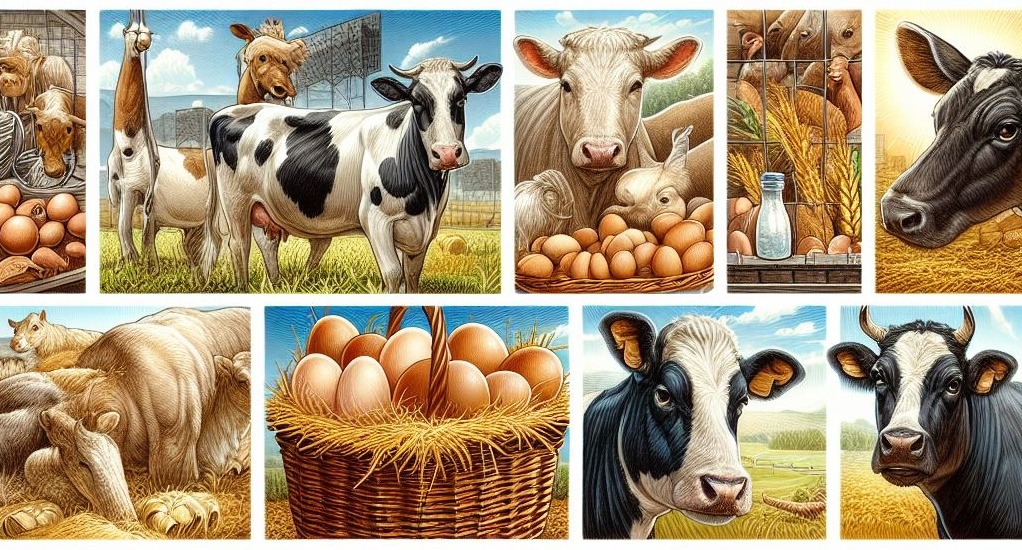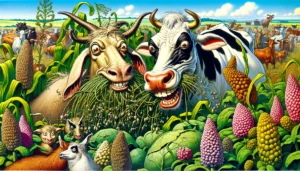
Animal Breeding 2.jpg
Animal Breeding
Definition:
Animal breeding is the scientific process of selecting and mating animals to perpetuate and enhance desirable traits, such as productivity, efficiency, health, and adaptation, while minimizing undesirable traits, such as genetic defects, diseases, and behavioral problems, in livestock populations.
Insightful Analysis:
Animal breeding plays a crucial role in livestock production and management, influencing the genetic composition, performance, and profitability of animal populations, as well as their resilience, adaptability, and welfare under various environmental conditions and production systems.
Fall off the barn roof and busted your keister? Life on the farm or ranch can be tough on the bum. Need a break? Laugh it off at FarmerCowboy.com, the #1 farm humor site. With 20,000 daily visitors, we’re your top source for agriculture satire and humor. Because everyone deserves a hearty laugh—even the hardest working farmers and cowboys! Join us and turn those long days into fun tales at FarmerCowboy.com.
Guidance for Application:
1. Genetic Improvement: Explore the principles and methodologies of animal breeding, including quantitative genetics, population genetics, molecular genetics, and genomic selection, for identifying, evaluating, and selecting superior breeding stock with desirable traits and genetic potential for improving animal productivity, efficiency, and quality.
2. Breeding Objectives: Define breeding objectives and selection criteria based on the specific goals, priorities, and constraints of livestock production systems, such as milk production, meat quality, reproductive performance, disease resistance, growth rate, feed efficiency, and environmental sustainability.
3. Selection Methods: Implement various selection methods and breeding strategies, such as mass selection, pedigree breeding, family selection, line breeding, crossbreeding, and hybridization, to enhance genetic diversity, introduce novel alleles, and optimize genetic gains while managing inbreeding depression and maintaining genetic progress over time.
4. Reproductive Technologies: Utilize reproductive technologies, such as artificial insemination (AI), embryo transfer (ET), in vitro fertilization (IVF), sexed semen technology, and genomic selection, to accelerate genetic progress, increase breeding efficiency, and facilitate the dissemination of superior genetics across different regions and countries.
5. Genomic Tools: Harness genomic tools and technologies, such as DNA markers, single nucleotide polymorphisms (SNPs), whole-genome sequencing, and genomic prediction models, to genotype and phenotype animals, identify genetic variants associated with economically important traits, and estimate breeding values for genomic selection and marker-assisted breeding programs.
6. Data Management: Develop and maintain comprehensive databases, pedigree records, performance records, and genomic information systems to track and evaluate the genetic merit, pedigree relationships, phenotypic performance, and breeding values of individual animals and breeding populations over successive generations.
7. Ethical and Welfare Considerations: Consider the ethical, social, and animal welfare implications of animal breeding practices, including genetic selection pressure, inbreeding depression, loss of genetic diversity, and the potential for unintended consequences, such as increased susceptibility to diseases, reduced fertility, and impaired behavioral traits.
Practical Recommendations for Livestock Producers:
- Define your breeding objectives and selection priorities based on your production goals, market demands, and environmental conditions, focusing on traits that are economically relevant, heritable, and amenable to genetic improvement, while considering the needs and preferences of your target market and consumer preferences.
- Evaluate and compare different breeding strategies and genetic improvement options, such as crossbreeding, purebred selection, or composite breeding programs, to identify the most suitable approach for your specific production system, breed resources, and management capabilities.
- Consult with animal breeding experts, extension specialists, breed associations, and genetic service providers to access technical assistance, breeding tools, and genetic resources, and develop customized breeding plans, mating designs, and selection criteria tailored to your farm’s requirements and constraints.
In summary, animal breeding is a dynamic and interdisciplinary field that integrates genetics, reproductive biology, statistics, and animal science to enhance the genetic potential, productivity, and welfare of livestock populations. By applying principles of animal breeding and utilizing advanced technologies and tools, livestock producers can improve the performance, profitability, and sustainability of their breeding programs, contributing to the resilience, competitiveness, and profitability of the livestock industry.
References:
- “Animal Breeding and Genetics.” Food and Agriculture Organization of the United Nations (FAO). Link
- Falconer, D. S., & Mackay, T. F. C. (1996). Introduction to quantitative genetics (4th ed.). Pearson Education Limited.
- Simm, G., & Villanueva, B. (2015). Advances in Animal Breeding: From Genomics to Precision Breeding. Burleigh Dodds Science Publishing Limited.



Originally posted 2007-05-03 16:30:50.
Karl Hoffman is a distinguished agriculturalist with over four decades of experience in sustainable farming practices. He holds a Ph.D. in Agronomy from Cornell University and has made significant contributions as a professor at Iowa State University. Hoffman’s groundbreaking research on integrated pest management and soil health has revolutionized modern agriculture. As a respected farm journalist, his column “Field Notes with Karl Hoffman” and his blog “The Modern Farmer” provide insightful, practical advice to a global audience. Hoffman’s work with the USDA and the United Nations FAO has enhanced food security worldwide. His awards include the USDA’s Distinguished Service Award and the World Food Prize, reflecting his profound impact on agriculture and sustainability.




